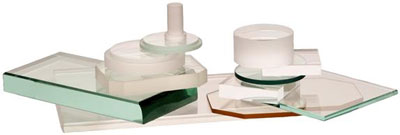 Santa Paula, CA – Abrisa Technologies finishes the sharp edges of cut glass substrates to insure not only safe handling, but also to reduce chipping, improve dimensional tolerance, increase functionality, and create a pleasing aesthetic appearance. Additionally, the overall performance of the glass is improved while adding to the strength and cleanliness of the cut glass substrate.
Santa Paula, CA – Abrisa Technologies finishes the sharp edges of cut glass substrates to insure not only safe handling, but also to reduce chipping, improve dimensional tolerance, increase functionality, and create a pleasing aesthetic appearance. Additionally, the overall performance of the glass is improved while adding to the strength and cleanliness of the cut glass substrate.
Typical glass substrate material includes soda-lime, borosilicate, glass-ceramics, quartz, and fused silica as well as other specialty glasses.
Edge Treatments provided by Abrisa Technologies include:
- Flat Ground Edges – Diamond embedded grinding wheels put a satin finish on the edge.
- Pencil Ground Edges – Diamond embedded grinding wheels put a satin finish on the edge with the edge radius similar to a pencil or C-shape.
- Flat Polished Edges – Taking a ground edge another step, polishing the edges to give the glass a nice sheen finish.
- Flat Polished w/ Arris – This is a flat polished edge with polished chamfers (Arris).
- Pencil Polished Edges – Edges are polished to a sheen finish, with radius similar to pencil or C-shape.
- Safety Seamed Edges – A sanding belt is used to lightly sand off the sharp edge of the glass.
- Dubbed Corners – The sharp edge of each corner if can be nubbed or broken as required (chamfered or radius corner)
- Stepped and Route Surfaces – Glass is ground away to leave a step or lip.
- Beveled Edges – Ground or polished bevels on glass or mirror, circles, rectangles to any degree can be provided
- Bullnose Edges (Half & Full) – These are typically polished edges (can be ground if required) that are similar to pencil edges, the difference being that a bullnose edge is a full radius curve where the diameter matches the thickness of the glass substrate. There are specific profiles where the relief angles can be different, typically where aesthetics are important or for critical applications where the edge of the glass could affect functionality.
General specifications for edging glass substrates are:
- Minimum Substrate Thickness: 0.020” (0.5 mm)
- Maximum Substrate Thickness: 1” (25.4 mm) – will have overall size limitations
- Tolerances: ±0.001” to ±0.010” dependent upon size and shape of glass parts
- Maximum Substrate Size: 110” x 60” (2794 mm x 1524 mm) up to 6 mm thick at this size. Can provide edge treatments for thicker substrates in smaller sizes. Consult factory
In addition to providing edge treatments to the glass substrate, Abrisa Technologies can also provide a variety of high performance coatings and other glass fabrication processes to the edge substrate providing a fully integrated optics solution.